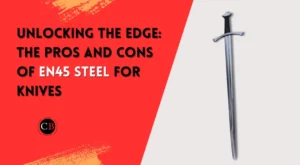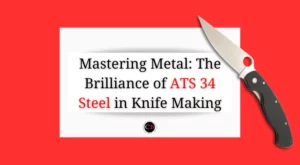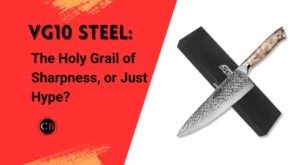Hello knife enthusiasts! Recently I came across LC200N steel. While searching for more details I came across statements like: “Best steel for EDC knives”. The obvious question is – what is LC200N steel and is LC200N steel good for knives?
I have prepared a concise review of the steel for you. Let’s dive into it to find out composition, hardness, edge-retention, and so on.
Table of Contents
What is LC200N steel?
LC200N is a high nitrogen alloy tool steel, which has excellent corrosion resistance and high toughness even at hardness up to 60 HRC. The main advantage is excellent machinability and polishability as well as high dimensional stability after heat treatment. For this reason, LC200N is the high-end solution for tools subjected to high static and dynamic loads in a highly corrosive environment at elevated temperatures. Other designations include Cronidur 30 and Z-FiNit.
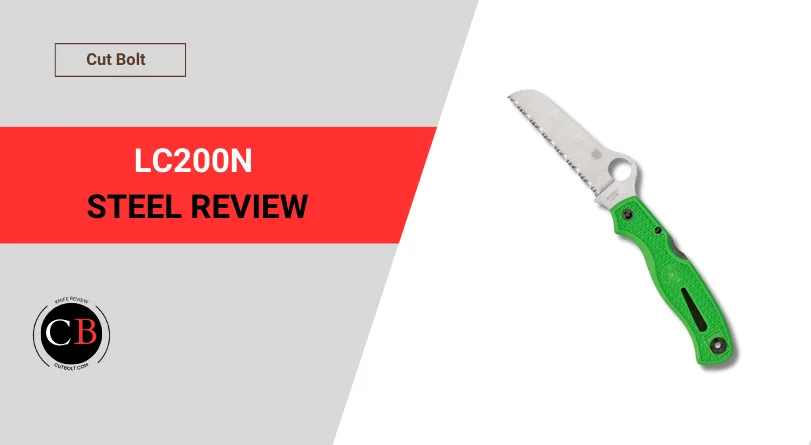
Who manufactures LC200N steel?
The Zapp Group, based in the United States, manufactures LC200N stainless steel. Zapp developed LC200N specifically for applications with high static and dynamic loads in corrosive and high-temperature environments. LC200N is widely used in the food, recycling, chemical and pharmaceutical industries.
LC200N steel is relatively new and was only introduced to the market in 2013. However, a closer look at its composition reveals that it has an almost similar chemical composition to Krupp’s Cronidur 30 stainless bearing steel. Cronidur 30 has been around for some time and was even used by NASA to make ball bearings. The steel is also known as Z-FiNit steel, where Z stands for Zapp and FiNit for fine-grained nitrogen steel.
Interestingly, NASA now seems to be moving toward Zapp LC200N and away from Cronidur 30 and AISI 52100 steels.
Like many other knife steels, LC200N was not originally developed explicitly for knife making, but it offers amazing performance in several categories that make it more than suitable for knife making. Spyderco already uses this steel for knife manufacturing.
LC200N steel chemical composition
| Element | Portion | Effect |
| Chromium | 15.0% | Improves wear resistance, heat resistance and scale resistance. It increases tensile strength because it acts as a carbide former. Use of rust-free or stainless steel, as it increases corrosion resistance from a mass proportion of 12.2%. Reduction in weldability. |
| Carbon | 1.0% | Increasing hardness and tensile strength. In larger quantities, increase in brittleness and reduction in forgeability and weldability. |
| Manganese | 1.0% | Improves hardness and tensile strength. |
| Molybdenum | 1.0% | Improves hardenability, tensile strength and weldability. Reduction in forgeability and ductility. |
| Nickel | 0.5% (max.) | Nickel increases tensile strength and yield strength. From 8% increase in corrosion resistance. |
| Nitrogen | 0.5% (max.) | Austenite former, increasing strength and corrosion resistance. |
As you can see it is very well balanced: Nickel for toughness, nitrogen and carbon for hardness and edge retention, and chromium for corrosion resistance.
Related: Pros and Cons of 1095 Cro-Van steel for knife making
Is LC200N stainless steel?
Yes, LC200N is a stainless steel, because it contains more than 11% chromium and its percentage of ferrous companions is less than 0.025% by mass. Read more about stainless steel here (Wikipedia).
What is the hardness of LC200N?
LC200N boasts a working hardness of 58-60 HRC, aligning with high-end steels like VG10, S35VN, and 154CM. It excels with superior corrosion resistance, toughness, and surpasses standard tool steels in hardness. Remarkably, it maintains tempering resistance up to 500°C.
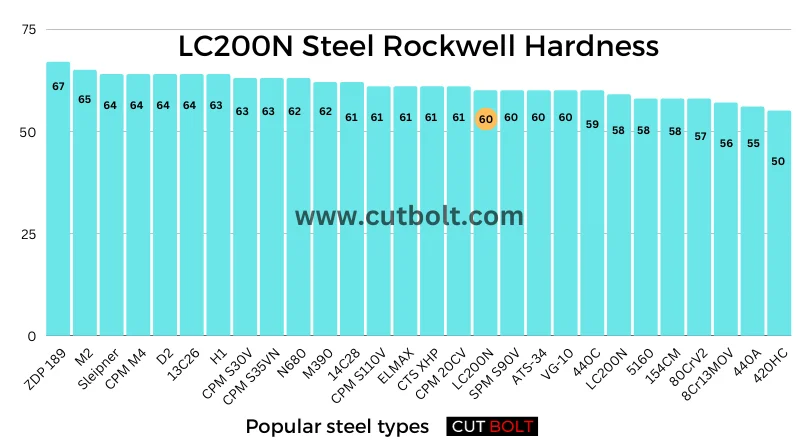
LC200N Steel Properties
Let’s find out the main properties of this blade steel in key areas such as wear resistance, edge retention, corrosion resistance, toughness, sharpenability and machinability. According to its chemical composition and hardness, LC200N steel has the following properties:
Edge retention
LC200N steel has high edge retention due to the combination of nitrogen and carbon with a hardness of 58 HRC on average.
The edge retention of LC200N is excellent and very close to that of Crucible CPM S30V another stainless steel known for its exceptional edge retention. In other words, the edge of an LC200N knife does not deform very easily with continued use. The strong cutting edge of LC200N allows it to stay sharp for months during regular cutting tasks without significant dulling.
Corrosion resistance
If you want to know what it’s like to have a 100% rust-free knife (well, let’s be honest, let’s say 99.999%), you should get a knife made of LC200N steel. This steel is exceptionally corrosion resistant and can withstand streams of sweat, water and salt water without staining – LC200N is ultra rust-free steel, so to speak!
This also explains why LC200N is or should be, the first choice for making fishing and kitchen knives. Ambitious anglers love this steel for its unique properties. It allows cutting bait, cleaning it in salt water, and filleting fish seamlessly. The knife stays corrosion-free throughout, and there’s no worry about rust stains at the end of the day.LC200N is therefore one of the best steels for saltwater knives.
Wear resistance
LC200N steel offers decent wear resistance, but none comparable to steels such as D2, which has tremendous wear resistance. Nonetheless, this steel offers good wear resistance. Good enough to withstand average daily use and prevent the edge from deforming when cutting various materials.
Sharpness
Sharpening LC200N is a comparatively easy task. Its fine grain structure makes it effortless to get it razor sharp. If you want to try to improve your knife sharpening skills, this steel is an excellent starting point. Since LC200N steel has high edge retention, it will not require frequent sharpening aside from a few touch-ups here and there if you want it keep it optimally sharp.
Toughness
Good toughness – very balanced compared to hardness and corrosion resistance.
LCN200N is relatively tough and offers good resistance to chipping, cracking or fracturing under stress or impact. Its toughness is quite similar to that of H1 steel.
LC200N kitchen knives are known to handle multiple tasks in the kitchen, such as cutting fruit (acid) on the one hand and working on meat bones and other demanding jobs without splintering on the other.
This good toughness also makes this steel suitable for making reliable fishing, filleting and hunting knives.
Machinability
LC200N is very machinable, knifemakers can’t go wrong here.
Similar steels like LC200N
When looking at the profile of LC200N and especially its exceptional corrosion resistance, H1 or VG-10 most likely comes to mind immediately.
One could perhaps even go so far as to say that LC200N is the logical evolution of H1 steel – apart from the fact that it can of course be compared to many high-end steels, even Bohler’s premium M390 steel.
I have compared a few steels similar to LC200N in many ways for better understanding:
LC200N steel vs H1
Both H1 and LC200N are nitrogen steels, with many knife steel experts believing that LC200 is the improved version of H1. H1 is a softer steel than LC200N which has a positive effect on its edge retention (LC200N). In other words, the edge retention of H1 is not quite as good and an H1 blade will dull faster in hard use.
H1 outperforms LC200N in terms of toughness and holds up well in hard use. Both the steels has one thing in common, they are extremely corrosion resistant (also, both are considered rust-free) and are comparatively easy to sharpen. H1 is better suited for serrated knives, while LC200N offers better performance on the smooth edge.
LC200N vs CPM S30V
CPM S30V is a premium knife steel and it would be interesting to see how it compares directly against LC200N. Both steels have great edge retention that is very close, although S30V still comes out a tad ahead here. S30V is also a harder steel than LC200N and can take a lot of abuse and hard use.
LC200N outperforms S30V in the ease of sharpening, maintenance requirements, and susceptibility to rust. S30V also has excellent corrosion resistance, but can rust at times with prolonged exposure to adverse weather conditions.
LC200N vs VG10
VG10 and LC200N are nearly identical in their properties. LC200N only has an edge over VG10 in corrosion resistance. Both steels offer fantastic edge retention, with VG10 having a very slight edge here. Both steels offer high toughness and are comparatively easy to sharpen.
LC200N vs 20CV
CPM 20CV has excellent performance all around and is pretty much identical to Bohler M390. LC200N would beat 20CV with its massive corrosion resistance, however, 20CV has a 20% chromium content and still offers excellent corrosion resistance.
However, LC200N cannot match the tremendous wear resistance and edge retention of 20CV. In addition, sharpening a 20CV blade is a challenging task. When faced with the choice of these two options, LC200N should only be considered if the knife will be used primarily in salt water and/or in humid or otherwise corrosive conditions. Otherwise, a 20CV knife may be a better choice for an all-around knife for a wide variety of applications.
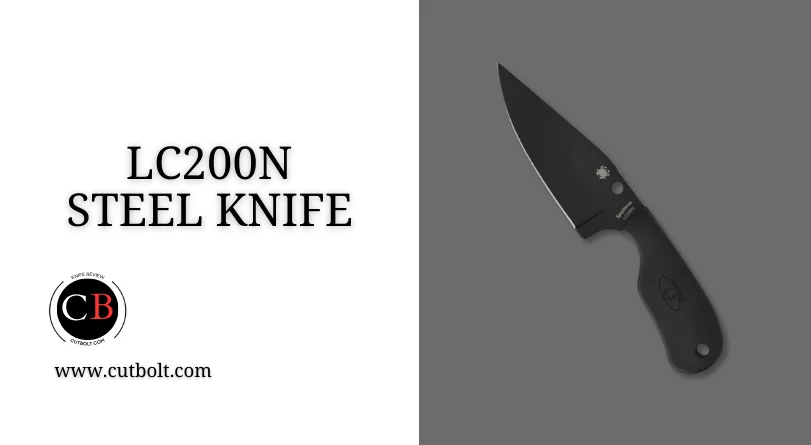
Is LC200N a good knife steel?
Well, it depends on the application. It is certainly not the first choice for those who need or want maximum edge retention. Because the perfect steel that can do everything equally well at the highest level does not exist.
The balanced composition of its properties makes it interesting for the average user who wants an easy-care everyday knife with a resilient blade that he can easily get sharp again.
LC200N knife steel outperforms most other knife steels in important areas and is definitely a good steel for making high-performance knives. The extremely high corrosion resistance of LC200N makes it a good choice for making knives for use in wet and saltwater conditions such as fishing, angling, hunting, cooking, and so on.
The steel also offers high edge retention and can handle a variety of cuts without becoming dull, most importantly; sharpening LC200N is comparatively a breeze! The Z FiNit toughness is also sufficient to avoid problems with chipping, cracking, or fracturing that (can) occur with knife steels that tend to be less tough.
Because it meets all the key categories for knife steels, it is undoubtedly a great all-around steel that outperforms most other steels on the market.
For this exceptional performance, you have to dig deeper into your pocket, because knives made of LC200N are only available at premium prices. Spyderco is a top brand here, using LC200N for a wide variety of knives and is universally popular.
Final words: How good is LC200N steel for making knives?
I like to understand the steel of a knife better because it gives you a better understanding of its performance. LC200N is a high-quality steel and is extremely well-balanced in its properties. Edge retention, hardness, toughness, corrosion resistance, and the ease of sharpening it balance each other out almost perfectly, which is rare to find. Unfortunately, apart from some Spyderco knives, it is not widely available.
If you intend to get an EDC made of LC200N to use it preferably in humid environments is certainly not doing anything wrong. For pure “dry use,” the anti-corrosive properties are perhaps a bit too much of a good thing, although good corrosion resistance is never a mistake.

